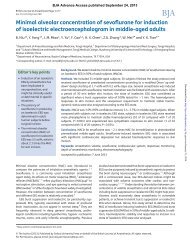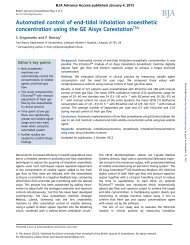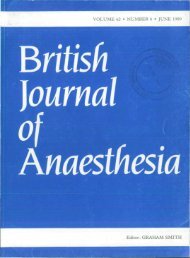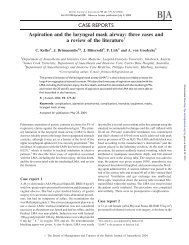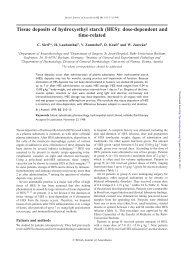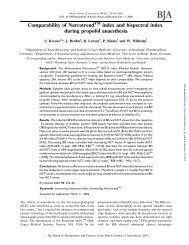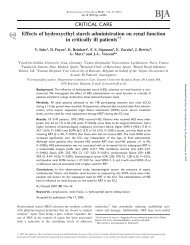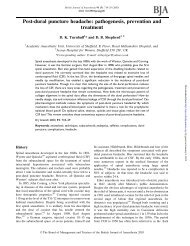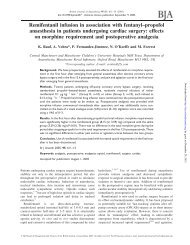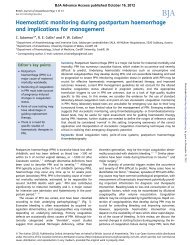Postoperative pain after abdominal hysterectomy: a ... - BJA
Postoperative pain after abdominal hysterectomy: a ... - BJA
Postoperative pain after abdominal hysterectomy: a ... - BJA
You also want an ePaper? Increase the reach of your titles
YUMPU automatically turns print PDFs into web optimized ePapers that Google loves.
<strong>BJA</strong><br />
Perniola et al.<br />
Total number of patients operated during the study time period:<br />
150 patients<br />
Did not fulfil inclusion<br />
criteria or had one of the<br />
exclusion criteria: 75 patients<br />
Number of patients interviewed<br />
for possible inclusion in the<br />
study: 75 patients<br />
Group P<br />
(Patient-controlled i.p. analgesia):<br />
20 patients<br />
Number randomized into the study:<br />
40 patients<br />
Patients included for primary endpoint:<br />
20 patients<br />
Patients excluded due to missing data for<br />
secondary endpoints in 1–3 patients*<br />
Fig 1 Flow diagram of screened, excluded, and recruited patients. *See Tables for details.<br />
• Refused to participate<br />
• Not able to understand study<br />
protocol because of language limitation:<br />
35 patients<br />
Group C<br />
(Continuous i.p. infusion):<br />
20 patients<br />
Patients included for primary endpoint:<br />
20 patients<br />
Patients excluded due to missing data for<br />
secondary endpoints in 1–3 patients*<br />
Downloaded from http://bja.oxfordjournals.org/ by guest on January 17, 2014<br />
The total volume of levobupivacaine administered <strong>after</strong> the<br />
first 24 postoperative hours was statistically significantly lower<br />
in Group P (180 ml) than in Group C (240 ml) (P,0.01).<br />
The recovery times and time to home-readiness are shown<br />
in Table 3. A statistically significant difference between the<br />
groups was found in the return of GI function, which was<br />
shorter in Group P compared with Group C. The mean time to<br />
home-readiness was statistically significantly shorter in<br />
Group P compared with Group C, while the length of hospital<br />
stay did not differ significantly between the groups. Expiratory<br />
muscle function, measured as maximum expiratory pressure<br />
(P Emax ), decreased at 4 h compared with preoperative values<br />
in both groups, and gradually recovered over time during<br />
48 h. However, no statistically significant differences were<br />
found between the groups at any time point (Table 3). The incidence<br />
of PONV and the number of patients who received<br />
anti-emetics did not differ between the groups. The sedation<br />
scores between the groups were similar (Table 4) and no differences<br />
were seen between the groups in any of the parameters<br />
of the health-related quality of life (SF-36), or the average score<br />
in SF-36 at 1 or 3 months <strong>after</strong> surgery (Fig. 3).<br />
Discussion<br />
In this study, we found a statistically significant opioid-sparing<br />
effect when patients self-administered bolus doses of levobupivacaine<br />
compared with those having acontinuous infusion of<br />
LA. Furthermore, there was a faster return of GI function and a<br />
Page 4 of 9



